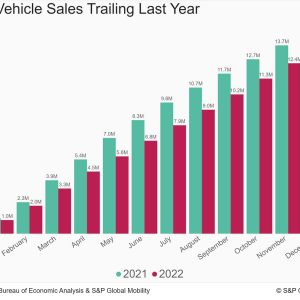
S&P Global Mobility: November auto sales continue previous three-month trend
This short article was released by S&P Global Mobility and not by S&P Global Ratings, which is an individually handled division of S&P Global.
Ongoing financial headwinds suggest no news could be good news
concerning automobile need levelsWith volume for the month predicted at 1.122 million systems,
November U.S. auto sales are approximated to equate to an approximated
sales speed of 14.1 million systems (seasonally adjusted annual rate:
SAAR). This would represent a continual enhancement from the May
through September period but will reflect a decrease from Octobers.
14.9 million-unit speed, according to S&P Global Mobility.
analysis.The daily selling rate metric in November (approximately 44-45K.
per day) would be in-line with levels since September. Translation:.
From a non-seasonally adjusted volume perspective, vehicle sales.
continue to plug along at a steady rate.” Sales need to continue to enhance, provided the anticipated sustained,.
Mild, advancement in general production and stock levels,”.
stated Chris Hopson, primary analyst at S&P Global Mobility.
” However, we likewise continue to keep an eye on for signals of.
faster-than-expected growth in stock. Currently, there are no.
clear signs; inventories have advanced as anticipated. Any.
indication of faster than projected growth in the overall stock of.
brand-new cars might imply that car customers are feeling the.
pressure of the existing financial headwinds and pulling back from the.
market.” As an outcome, Octobers SAAR increase is most likely to be an anomaly.
compared to the rest of the year, Hopson stated, including that.
there are expectations of volatility in the regular monthly results.
beginning in early 2023. Market share of battery-electric cars is expected to reach.
5.9% in November. However, outside of the big seaside cities,.
retail registrations of EVs have yet to take hold, according to.
analysis from S&P Global Mobility.The top-eight EV markets in the US are all in coastal states and.
represent 50.5% of overall EV registrations so far in 2022 (through.
August). The greater Los Angeles and San Francisco city.
locations alone account for nearly one-third of overall share of the United States.
EV market. The Heartland states market share of EV sales.
is hardly half of what they contribute to total vehicle.
registrations.” BEV market share control on the 2 coasts is associated to.
their higher mix of early adopters compared to purchasers in middle.
America,” stated Tom Libby, associate director of Loyalty Solutions.
and Industry Analysis at S&P Global Mobility. “Their.
demographic profile is more in sync with the traditional BEV buyer.
than the middle-American profile.” But Libby sees prospective for EV approval in leading heartland.
markets: “More acceptance and much broader consumer awareness is.
resulting in a natural development of adoption from the coasts to.
the Heartland.” (For more on this analysis of EVs in the Heartland,.
please see.
this unique report.) Supporting the EV advancement, product exposes surrounding the.
Los Angeles Auto Show recently continue to reflect the OEM.
focus.According to Stephanie Brinley, associate director of.
AutoIntelligence at S&P Global Mobility, “As automobile programs at.
their best highlight what individuals will be driving in coming years,.
the exposes during the Los Angeles Auto Show show the continuing.
push towards electrical and energized vehicles.” Of note, Fiat announced it will bring a version of the European.
500 EV to the U.S. beginning in early 2024, reviving the 500e.
nameplate. Toyotas expose of the 2023 Prius hybrid consisted of a.
Prime trim that will double the hatchbacks EV-only variety, while.
the automaker also revealed a making of the bZ (” Beyond Zero”).
electric-vehicle principle, previewing an upcoming compact SUV.
Meanwhile, Vietnamese entrant VinFast showed U.S.-trim versions of.
two EV crossover additions to its lineup – bringing its capacity.
US offerings to four.
Leave a reply